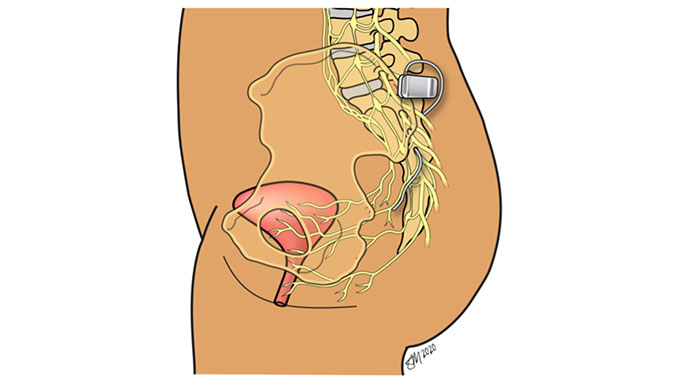Sacral Neuromodulation (SNM)
 Sacral neuromodulation (SNM) is an attractive surgical option for women with overactive bladder/urgency urinary incontinence, anal incontinence or both, as well as urinary retention. This minimally invasive treatment involves implantation of a small battery which provides gentle stimulation to the nerves that control the bladder and bowel.
Sacral neuromodulation (SNM) is an attractive surgical option for women with overactive bladder/urgency urinary incontinence, anal incontinence or both, as well as urinary retention. This minimally invasive treatment involves implantation of a small battery which provides gentle stimulation to the nerves that control the bladder and bowel.How is SNM performed?
To determine if sacral neuromodulation is right for you, you will undergo a temporary evaluation phase. In the office, a small wire is placed through the skin in the back, close to the nerves that control the bladder and bowel. The wire is connected to an external neurostimulator or pacemaker for three days. This evaluation period allows you to determine the level of symptom relief you can expect before proceeding with the treatment. If you and your urogynecologist determine sacral neuromodulation is the right treatment for you, you will then undergo an outpatient procedure to place a permanent neurostimulator about the size of an Andes mint. Following the procedure, you will be able to either increase, decrease or turn off the stimulation with an easy-to-use controller.How will I know my symptoms are improved?
Sometimes bladder or bowel symptoms can be hard for women to describe or quantify. To better help you understand your response to the test and treatment, your surgeon will ask you to fill out a voiding diary, keeping track of how many times you go to the bathroom as well as the number, if any, of leakage episodes. This is typically done before and during the test phase.How successful is sacral neuromodulation therapy? How long will it last?
SNM therapy is an excellent option for women who have not found relief with other treatments like lifestyle changes, pelvic floor physical therapy or medications. Modern SNM devices can last anymore from five to 15 years and there are rechargeable battery options.What are the risks of an SNM procedure?
When sacral neuromodulation is performed by a board-certified urogynecologic surgeon, problems with SNM placement are rare. Rarely, women can experience infection or pain at the implantation site, which might require your urogynecologic surgeon to remove the device.If you experience a fall or accident, the SNM lead might move out of place, which can affect your symptom control. You should contact your urogynecologist if either of these situations happen so they can evaluate whether the wire has moved and correct it placement if necessary. SNM is a reversible procedure, and the device can be removed and or replaced in the operating room.
Meet Our Urogynecologists

Urogynecology and Reconstructive Pelvic Surgery

Urogynecology and Reconstructive Pelvic Surgery

Urogynecology and Reconstructive Pelvic Surgery

Urogynecology and Reconstructive Pelvic Surgery

Urogynecology and Reconstructive Pelvic Surgery
